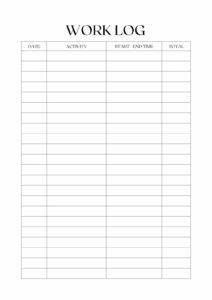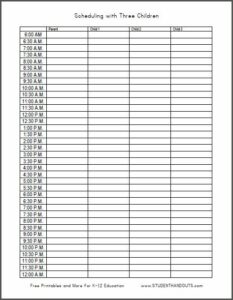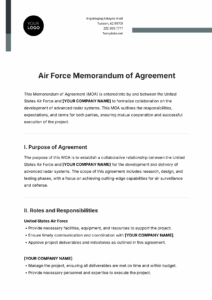Ever feel like your days vanish into thin air, leaving you wondering where all the time went? It’s a common dilemma in our fast-paced world, where distractions are abundant and responsibilities constantly vie for our attention. We often start with good intentions, aiming to tackle our to-do lists, only to find ourselves derailed by unexpected tasks, digital pings, or just plain procrastination. Understanding how we actually spend our hours, versus how we think we spend them, is the first crucial step towards gaining control.
This is where a simple yet incredibly powerful tool comes into play: the activity log. By meticulously documenting your daily actions, you gain unparalleled insight into your habits, productivity peaks, and notorious time sinks. And to make this process as straightforward as possible, having a well-designed time management activity log template can streamline your efforts, turning a potentially tedious task into an illuminating journey of self-discovery and efficiency.
Why Tracking Your Time Is a Game-Changer for Productivity
Many of us operate under the assumption that we know exactly where our time goes. We might feel busy all day, moving from one task to another, yet at the end of it, a sense of unaccomplishment can linger. The reality, however, often differs significantly from our perception. Without concrete data, our understanding of our own time usage is largely based on guesswork and memory, which can be surprisingly unreliable. This is precisely why engaging in time tracking with an activity log is not just helpful, but truly transformative for anyone serious about improving their productivity and overall time management skills.
When you begin to log your activities, you’re essentially holding a mirror up to your day. This unfiltered reflection allows you to see, often for the first time, the subtle ways time slips away. You might discover that those “quick” email checks turn into hour-long scrolling sessions, or that switching between tasks more frequently than you realize fragments your focus and extends completion times. The sheer act of writing down what you’re doing, and for how long, creates an objective record that doesn’t lie.
This objective data becomes the foundation for informed decision-making. Instead of vaguely trying to “be more productive,” you’ll have specific instances and patterns to analyze. You’ll identify your personal time thieves, those activities that consume your precious hours without contributing to your goals. This awareness is empowering because it shifts you from a reactive state to a proactive one, enabling you to consciously redirect your efforts where they matter most.
What to Include in Your Activity Log
For your activity log to be truly effective, it needs to capture a few key pieces of information. A robust time management activity log template will typically guide you through these entries, ensuring you collect comprehensive data for analysis.
- Start Time: When you began an activity.
- End Time: When you finished an activity.
- Activity Description: A brief, specific note on what you were doing (e.g., “Responded to client emails,” “Prepared presentation slides,” “Coffee break”).
- Duration: The total time spent on that activity (calculated from start and end times).
- Notes/Context: Any additional thoughts, distractions, or feelings associated with the activity.
The “Notes/Context” section is particularly valuable. It allows you to add qualitative data to your quantitative time entries. For example, you might note “felt energized” during a creative task or “struggled to focus due to notifications” during a deep-work session. These insights help you understand not just what you’re doing, but also the conditions that contribute to your productivity or lack thereof. Consistency in logging is paramount; the more diligently you track, the clearer and more accurate your picture of time usage becomes, laying a solid groundwork for improvement.
Maximizing the Insights from Your Time Log
Once you’ve diligently tracked your time for a few days or even a week using your time management activity log template, the real magic begins: analysis. Simply logging your activities is a great start, but the true power comes from reviewing that data and drawing actionable conclusions. This step moves beyond mere observation to strategic planning, allowing you to transform raw data into a roadmap for enhanced efficiency and goal attainment.
Start by looking for patterns. Are there specific times of day when you are most productive? Conversely, when do you tend to hit a slump or get sidetracked? Identify recurring tasks that take longer than expected, or those seemingly small interruptions that collectively consume significant chunks of your day. You might discover that you spend an hour each morning on non-essential emails, or that unscheduled meetings consistently disrupt your workflow. These insights are incredibly valuable for understanding your natural rhythms and identifying areas ripe for optimization.
With these patterns in hand, you can begin to make informed adjustments to your schedule and habits. This isn’t about becoming a robot, but about working smarter, not harder. You can start to implement strategies that align with your natural peak productivity times and mitigate distractions during your low periods.
Here are some practical steps you can take based on your log’s insights:
- Prioritize: Allocate your peak focus times to your most important, high-impact tasks.
- Delegate or Eliminate: Identify tasks that can be handed off or removed from your plate entirely.
- Block Time: Schedule specific blocks for deep work, email processing, or even breaks, and stick to them.
- Minimize Interruptions: Turn off notifications during focus times, or schedule specific times for checking messages.
Remember, improving time management is an iterative process. Your initial analysis provides a baseline, and as you implement changes, you can continue to log your activities to see the impact of those adjustments. This continuous feedback loop ensures that your time management strategies are always evolving and tailored to your specific needs and goals. By regularly reviewing your activity logs, you can refine your approach, ensuring that your precious time is spent on what truly matters, propelling you towards greater personal and professional success.
Embracing the habit of time tracking and thoughtfully analyzing your activity log is one of the most effective ways to take command of your daily life. It provides a clear, undeniable picture of your habits, allowing you to move beyond assumptions and make data-driven decisions about how you invest your hours. This simple practice lays the groundwork for a more intentional, productive, and ultimately, more fulfilling existence, giving you the power to shape your days rather than letting them merely happen to you.


